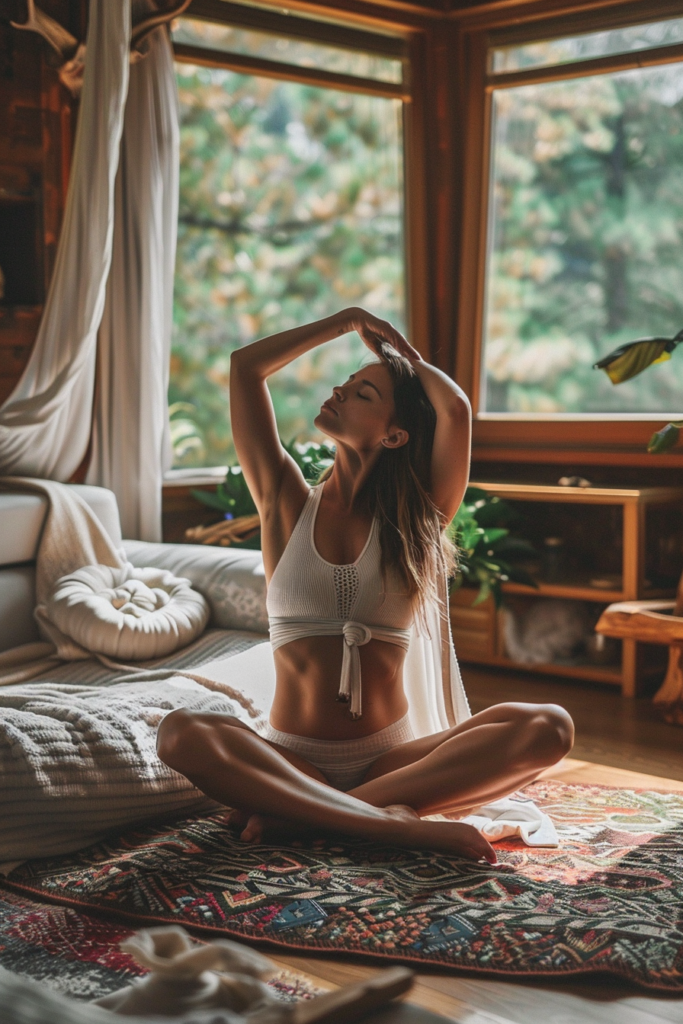Creating a Meditation Routine: Tips for Consistency
You know what meditation is, you’ve learned about different techniques, approaches and steps to start. Unfortunately—all that knowledge is kinda useless if you can’t incorporate it into daily life. Thus, why you need to create mindful habits. Learn how now!
Setting Realistic Meditation Routine Goals
Before you start, you need to set up a good mindset. This is crucial, as no matter how long you practice mindfulness every day, it won’t work, if you sabotage yourself.
What do I mean by that?
Imagine this: you start meditating with a goal of 30 minutes every day to calm after work. You may succeed in the first few days, but then it will get harder. And the harder it gets, the more frustrated you will be if you have no results.
In the end: you end up thinking that meditation is not for you, and just give it up completely.
Setting realistic goals is a key to avoid that kind of frustration. General rule of thumbs is: start with short, regular sessions, focused on easiest techniques. Don’t jump into 1-hour Buddha mantra mindful training.
Instead, start with 10-minutes of conscious breathing for 1–2 weeks. Your goal is to slowly build first of your mindful habits while also training your attention span.
Treat it as training. After all: you are not able to bench press 300 lbs on your first day at the gym, right?

Creating Your Ideal Meditation Space
Meditation space might sound like a lot of effort and work, but don’t worry: it’s not. The goal is to find a cozy corner in your home where you will be undisturbed by anyone.
What things do you need in that space? Well, it’s all up to you. But you can go with:
- Meditation cushion;
- Candles;
- Incense;
- Personal talisman, like pendant or favorite teddy bear.
The important thing is that the corner shouldn’t be in a transitive place, like a living room, where everyone runs around. Also try your best to make it as silent as possible. In the beginning, it’s hard to develop mindful habits when you are distracted by surroundings.
But what if you are living in a small apartment? Or a rented room?
Don’t worry! Just change something in your personal space before you jump into meditation. For example: if you meditate in an armchair, place it in a different spot than usual and light some candles. This way, your brain will know that it’s time to rest.
Establishing a Daily Meditation Routine
The easiest way to form mindful habits is to make them as easy to repeat as possible (at least in the beginning). A great way to start is setting up daily routines that you stick to for 1–2 weeks. As mentioned before: start with 10 minutes of conscious breathing.
It would be best if you set up a schedule with a fixed hour. After some time, your brain will crave by itself to start meditation at a given time.
One thing to note: daily routines change with time. And that’s perfectly fine, moreover: it’s desired. However, try to make them a little more challenging. For example: after 2 weeks of daily 10-minutes breath work, prolong it to 12 minutes.
Later on, add 5 minutes of muscle relaxation.
Incorporating Mindfulness into Daily Life
Creating a meditation routine is easier if you treat mindful habits not only as a 10-minute practice during a day. Instead, try to incorporate mindfulness into your everyday life. No matter where you are or what you are doing.
Sounds strange? Well, let me explain with some examples.
- Stressful situation at work – when under heavy stress, use the breath work you practice during meditation.
- Focus on the present during gym training – our minds often wander while we are training. That’s not good for your gains! Try to focus entirely on your sets, the same way you focus on observing your emotions while meditating.
- Pay attention to your surroundings – next time you go back from shopping, pay attention to what surrounds you. We tend to go on autopilot during everyday duties, but it’s good to notice those moments.
Of course, there are many more ways to incorporate mindfulness into daily life. The possibilities are only limited by your imagination!
Tracking Your Meditation Progress
That part of creating a meditation routine is kinda tricky. That’s because tracking meditation progress is not as simple as training results like swimming or running.
After all: it’s hard to say when exactly you lose focus during mindfulness practice. And if you look at the phone, there is a high chance you will get distracted even more.
So what can you do instead?
First: don’t worry too much about time in the first weeks. Set up a 10-minute timer and go with your chosen technique. Then, as days pass, notice whether it is easier or harder for you to meditate for a whole 10 minutes.
After each session, write down your feelings. Did you make it till the end? Were you nervous? Or maybe it felt… too short?
Second: note how many times you got lost in thoughts during your meditation routine. Every time, just draw a small line in your notebook and go back to your mindful practice. Sum them up after the whole meditation.
This way, you’ll notice whether you have a better or worse time focusing.
Last but not least: don’t be too hard on yourself. Even if you notice that you lost focus more times and couldn’t reach 10 minutes, though you did yesterday – it’s perfectly fine. I often had worse days, when even 5 minutes was hard!
Meditation is something you practice daily. It’s a life-time journey, not a sprint to finish.
Staying Motivated and Satisfied
To start a mindful habit you need to make it obvious, attractive, easy and satisfying. I’ve covered that HERE, so check it out if you want to dive deeper.
However, keeping it simple and brutally honest: meditation routine in the beginning is probably… boring.
Thus, a good idea would be to reward yourself after finishing your spiritual practice. That can be literally anything, like:
- Eating favorite snack after;
- Making yourself delicious tea, coffee or other drink;
- Watching TV series;
- Starting your favorite game.
The goal here is to sort of “trick” your brain into associating meditation with something pleasurable. Thanks to that, you will stay motivated and satisfied. Especially in the beginning, when you might not yet feel the effects of mindful habits yet.
After some time, they will be rewards in themselves!
Adapting Your Meditation Routine to Life’s Changes
The whole process of adapting mindful habits to life’s changes is a little more advanced technique. However, you can use the basis even when you are a beginner. And they work wonders to keep you consistent.
Keeping it simple, you can adapt your meditation routine in 2 ways:

- Change your schedule and duration – it’s best to start meditating at roughly the same hour every day and spend the same amount of time. But if you have a sudden night-shift, need to make a longer trip, just reschedule your mindful practice. It’s way better to meditate for just 5 minutes than give up completely!
- Adapt the technique – different mindful practices bear different fruits. So why not use that to your advantage? If you feel the need to change your meditation technique to a different one due to life’s changes, do it!
And of course, you can blend those 2 techniques together. Here is an example on how to put that into practice:
- Let’s say you practice 15 minutes of mindful breathing every evening. But due to a change in work schedule, you are now going to the gym at later hours. Thus, you can’t meditate in the evening. What’s more: due to being stressed after work, you feel more tense than before after your workouts.
- It’s a perfect time to try 10-minute of body scan meditation or progressive muscle relaxation. You do it after every workout and nice, warm shower.
- That way, you have an easier time adjusting, because your meditation routine is shorter. At the same time, the new technique better suits your current needs.
Of course—that’s just an easy example. Feel free to experiment, and if you want to learn more about beginner-friendly techniques, check out my other guide.
Conclusion: Creating a Consistent Meditation Routine
Establishing mindful habits might be hard in the beginning. But it’s not that different from forming other healthy habits, like drinking enough water, training, cycling, going for walks etc. It just might take some time before you notice progress.
Remember: go at your own pace. It’s absolutely normal to forget your meditation routine or skip it because you have a busy day.
Just wake up the next day and this time, don’t forget. In a few weeks, you will thank yourself for creating those habits. Thanks to them, you will slowly but steadily walk towards a better, more mindful life.
And HERE you can learn more about the benefits of meditation, if you are not yet convinced!
